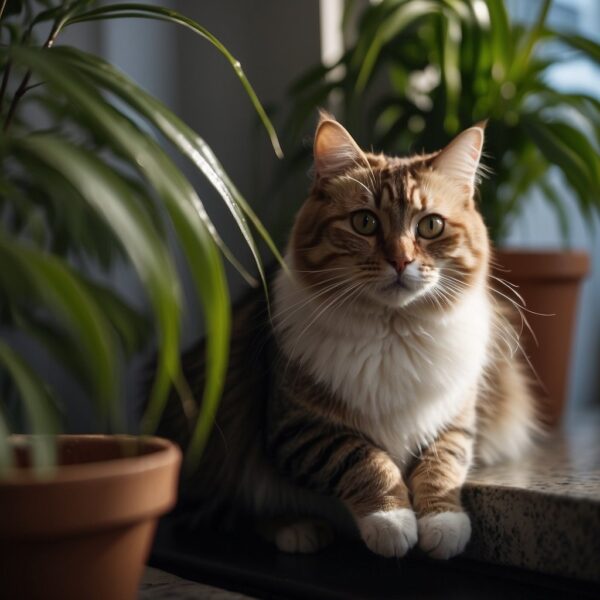
Spider Plants Are Safe for Cats: Unveiling the Facts
Spider plants, also known as Chlorophytum comosum, are a common choice for indoor greenery due to their ease of care and ability to thrive in a variety of environments. Are spider plants safe for cats? As cat parents often seek to coexist with plants, questions arise regarding the safety of such plants around their furry companions. When it comes to cats, who are known for their curiosity and tendency to nibble on greenery, the safety of spider plants in the home is an important consideration.
Though spider plants are not toxic to cats, they may cause mild digestive upset if ingested. Cats may be attracted to the long, arching leaves of the spider plant and occasionally chew on them, which can lead to vomiting or diarrhea. Responsible cat parents should monitor their cats and ensure that spider plants are placed out of reach if their cat shows an interest in chewing on the leaves. The non-toxic nature of spider plants makes them a relatively safe choice for households with cats, but care should still be taken to prevent any potential negative reactions.
Key Takeaways
- Spider plants are non-toxic and generally safe for cats.
- Ingesting spider plants may cause mild digestive issues in cats.
- Cats should be monitored to prevent them from nibbling on spider plants.
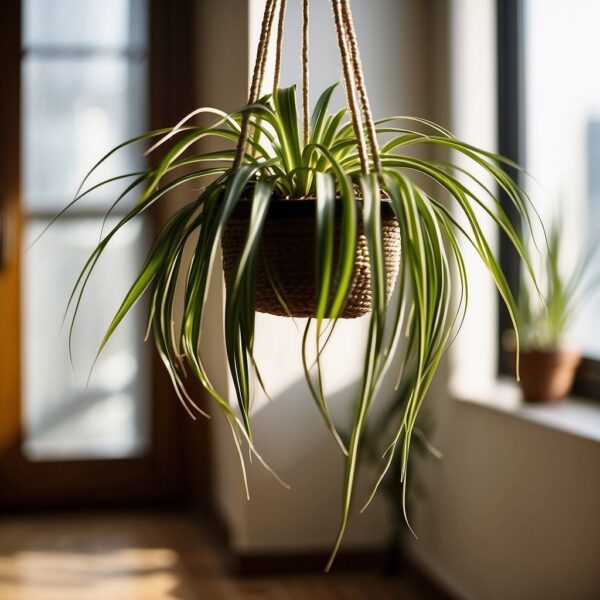
Understanding Spider Plants
Spider plants, scientifically known as Chlorophytum comosum, are cherished for their ease of care and air-purifying qualities. This section will provide insight into their botanical background, growing needs, and the different varieties that make them an appealing choice for gardeners and houseplant enthusiasts alike.
Botanical Profile
Chlorophytum comosum, commonly called the spider plant, is part of the Asparagaceae family. Originating from tropical and southern Africa, they’ve gained popularity globally due to their resilience and adaptability to various indoor environments.
Cultivation and Care
Spider plants thrive in well-draining soil and prefer bright, indirect sunlight. They are tolerant of a wide range of conditions but perform best when watered moderately—enough to keep the soil moist but not soggy. Gardening experts recommend allowing the top inch of soil to dry out between watering sessions.
Varieties and Characteristics
There are numerous varieties of spider plants, each with unique characteristics. Some common types include:
- Chlorophytum comosum ‘Variegatum’: Features leaves with white edges.
- Chlorophytum comosum ‘Vittatum’: Known for a central white stripe on the leaves.
- Chlorophytum comosum ‘Bonnie’: Has curly leaves and is more compact in size.
All varieties produce spiderettes or plantlets, which dangle from the mother plant and can be propagated easily, contributing to their appeal among gardening enthusiasts. When caring for these plants, it’s essential to balance light exposure, watering, and feeding to ensure robust growth and vitality.
Spider Plant Safety and Cats
When considering indoor plants, cat parents must evaluate the safety of plants like spider plants. It is essential to understand their toxicity levels, how they align with other non-toxic houseplants, and their influence on cat behavior.
Cats And Spider Plants: Toxicity Levels
Spider plants (Chlorophytum comosum) are deemed non-toxic to cats, as verified by the ASPCA (American Society for the Prevention of Cruelty to Animals). While they are not poisonous, ingestion may sometimes cause mild symptoms such as vomiting or diarrhea in cats. These instances are usually not severe but monitoring a cat after ingestion is prudent.
Common Non-Toxic Houseplants
In addition to spider plants, several other houseplants are considered safe for pets. Here are a few cat-friendly options:
- Bamboo Palm: A lush, non-toxic plant that adds tropical flair.
- Boston Fern: Offers feathery, non-toxic fronds that are safe for cats.
- Areca Palm: Another non-toxic choice offering a burst of greenery.
Plants like pothos and peace lily should be avoided, as they are toxic to cats and can cause more severe symptoms.
Spider Plant and Cat Behavior
Cats may be attracted to spider plants because of the mild hallucinogenic properties found in the plant, similar to those in catnip. While they are not harmful, this can explain why cats sometimes show an unusual interest in these plants. It is advisable to keep spider plants out of reach if a cat is known to nibble on houseplants. Hanging baskets are a practical solution to keep the plants away from cats while also adding aesthetic appeal to the home.
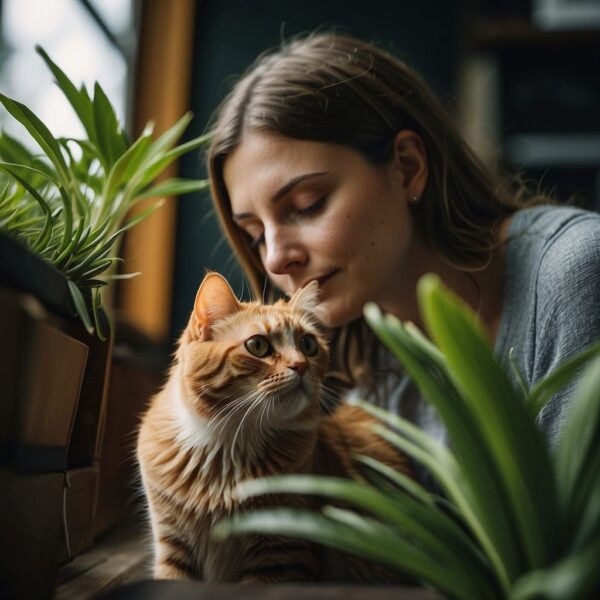
Health Considerations for Cats around Spider Plants
When discussing the safety of spider plants for cats, it is essential to understand how to identify potential toxicity symptoms and the appropriate measures to take should these arise. While spider plants are generally considered non-toxic, they can sometimes cause mild gastrointestinal upset in cats.
Recognizing Toxicity Symptoms
Common symptoms of plant toxicity in cats can include:
- Vomiting: An immediate reaction where the cat expels the contents of its stomach.
- Diarrhea: Loose or watery stool that could indicate irritation in the digestive system.
- Drooling: Excessive salivation may be a reaction to an upset stomach or irritation.
- Loss of Appetite: The cat may show a diminished interest in food.
- Lethargy: Cats may appear unusually tired or disinterested in normal activities.
These symptoms may result from a cat’s natural propensity to chew on spider plant leaves. While the spider plant is not highly toxic, its mild hallucinogenic properties can lead to an upset stomach or peculiar behavior in cats.
Immediate Actions and Veterinary Care
If a cat exhibits any of the above symptoms after ingesting spider plant leaves:
- Remove the plant from the cat’s environment to prevent further ingestion.
- Observe the cat closely, noting the persistence and severity of symptoms.
In many cases, the discomfort will subside on its own. However, if symptoms are severe or persistent:
- Contact a veterinarian: Professional advice is crucial to determine if further action is needed.
- Provide relevant information: Let the vet know about the plant ingestion and symptoms observed.
- Follow instructions: The veterinarian may recommend home care or an office visit.
Seeking veterinary attention is important when the cat’s symptoms are concerning. A veterinarian can provide the necessary care and guidance to ensure the cat’s well-being.
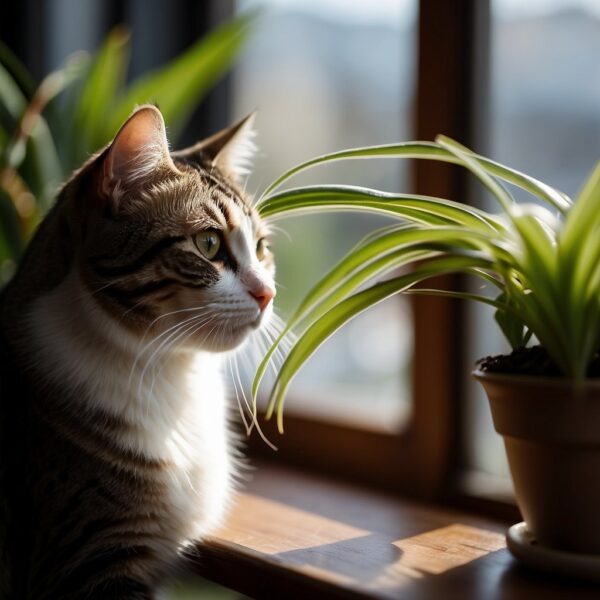
Environmental Enrichment for Cats
Cats require both mental and physical stimulation to maintain their well-being, and incorporating plants into their environment can contribute to these essential needs.
Safe Interactive Plants
Certain plants can safely provide sensory stimulation for cats. Plants like catnip and spider plants emit a scent that many felines find irresistible, encouraging playfulness. Boston ferns and varieties of grass grown specifically for cats can also be good choices. These plants offer a non-toxic way to add indoor greenery that your feline friend can interact with without the risk of poisoning.
- Recommended Safe Plants:
- Spider Plant (non-toxic, but can induce a mild, harmless reaction)
- Catnip (provides mental stimulation)
- Pet-safe Grass (offers a safe grazing option)
- Boston Fern (non-toxic and easy on feline digestive systems)
Preventing Plant Munching
While some plants are safe, it’s important to prevent your cat from chewing on them excessively. Over-indulgence can lead to upset stomachs or vomiting. Therefore, keeping plants out of reach, such as in a hanging basket, can minimize this risk. For cats drawn to household greens, providing safe alternatives for chewing can redirect this natural behavior away from your other houseplants.
- Strategies to Limit Plant Eating:
- Hang plants in areas cats cannot access
- Offer designated cat grass or catnip alternatives
- Use deterrents like scent-based repellents near non-safe plants
Utilizing plants for environmental enrichment can enhance your cat’s quality of life, but it’s essential to choose non-toxic varieties and to implement strategies that keep both the plants and your cat safe.
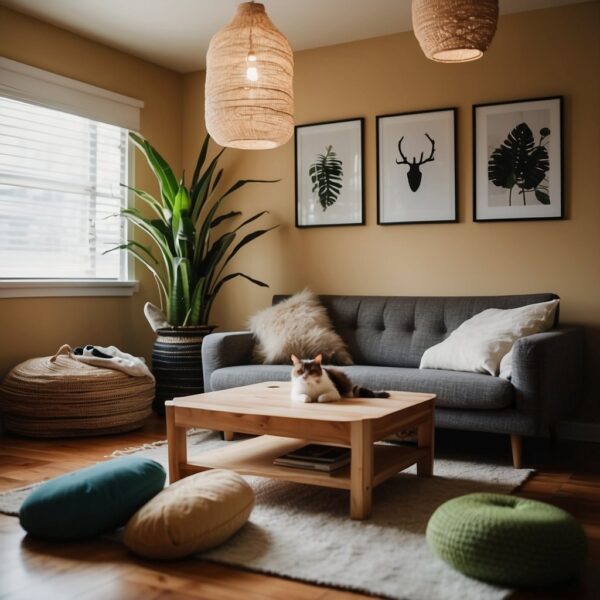
Practical Cat Care Tips
When considering the safety of spider plants in a home with cats, guardians need to ensure that the plants are placed and maintained in a way that minimizes risk. Even non-toxic plants like spider plants can cause discomfort if a cat consumes them excessively.
Safe Placement of Houseplants
Hanging Baskets: Placing spider plants in hanging baskets helps to prevent cats from accessing them. To maximize safety, the hanging planter should be placed away from furniture that the cat could climb.
| Location Type | Considerations |
|---|---|
| Ceiling Hooks | Secure and out of reach; check for cat’s jumping capability |
| High Shelves | Should be without climbing access |
| Detached Stands | Ensure they are not easily toppled by cats |
Note: Avoid places where leaves can dangle within a cat’s reach, enticing them to jump or climb.
Plant Safety Precautions
Monitoring and Deterrents: Cats naturally gravitate towards plants. Parents should monitor their cats’ behavior with houseplants. Should a cat show too much interest, safe deterrents can be used. Citrus peels, for example, can act as a natural repellent due to their scent.
- Pruning: Regularly prune plants to remove accessible leaves.
- Cat Grass: Provide cat grass as a safe alternative for cats to chew on.
- Toxin Removal: Propagate new plants to replace any that have been treated with potentially poisonous chemicals.
- Vomit Prevention: While spider plants are not harmful, ingestion can still lead to vomiting. Remove any damaged plant parts that a cat might ingest.
By taking these specific preventative measures, parents can ensure the safety and well-being of their feline companions while also enjoying the presence of houseplants like the spider plant.
Frequently Asked Questions
When it comes to feline safety and houseplants, cat parents often have specific concerns. This section addresses common questions about spider plants and their effects on cats.
What are the effects of spider plants on cats?
Spider plants are not toxic to cats. However, they can cause mild digestive upset, such as vomiting or diarrhea, if consumed in large quantities due to their mild hallucinogenic properties.
Can spider plants cause any harm to dogs?
The spider plant is also non-toxic to dogs. Similar to cats, ingestion might lead to mild gastrointestinal upset, but it does not pose a serious threat to a dog’s health.
How can one prevent cats from chewing on spider plants?
To prevent cats from chewing on spider plants, one can keep the plants out of reach, use deterrent sprays on the plants, or provide the cat with alternative plants that are safe for chewing, like cat grass.
What are some safe houseplants for cats?
Some safe houseplants for cats include the Boston fern, bamboo palm, and African violet. These plants can be kept indoors without posing a risk to feline health.
Is there a plant that is considered the most toxic to cats?
Lilies (Lilium and Hemerocallis species) are extremely toxic to cats and can cause acute kidney failure. It is critical to avoid keeping lilies around cats.
What should I do if my cat ingests part of a spider plant?
Should a cat ingest part of a spider plant, monitor the cat for signs of digestive upset. Typically, no medical intervention is required, but if symptoms persist or worsen, consult with a veterinarian.